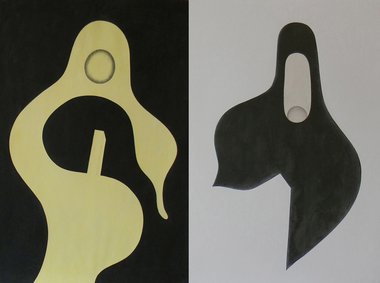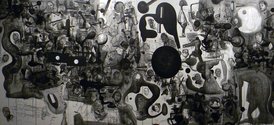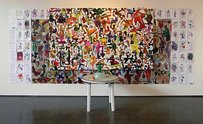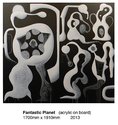John Hurrell – 1 November, 2013
The 'abstract' works on loose sheets of paper, though referencing the body, are devoid of overt figuration, like faces or clothed figures. They feature dominant grey or black tones that articulate negative shape and silhouetted arabesque curves, most having an appealing looseness and casual manner that is lost with the painted canvases.
With this exhibition of drawings, paintings, a wall installation and collaborations with an animator and a quiltmaker, we see a range of Mark Braunias’s recent endeavours. Work that only spasmodically doubles up on his recent shows at Film Archives and Ilam Campus.
The ‘abstract’ works on loose sheets of paper, though referencing the body, are devoid of overt figuration, like faces or clothed figures. They feature dominant grey or black tones that articulate negative shape and silhouetted arabesque curves, most having an appealing looseness and casual manner that is lost with the painted canvases. Their brushed-in backgrounds close in on the forms too tightly and - for me - squeeze out the spontaneity. And the images are either too crowded or the colour choices not so nuanced. A bit garish.
Despite what I have just said, some of the great drawings are not loose. There is a grid of tightly executed, coloured pencil drawings that are the exhibition’s highlight. The sixteen images have a gorgeous moulded plasticity, focusing on blobby amoeboid forms that sometimes transmute into quivering female genitalia and other bits. They are so delicate - almost diaphanous with their fine hatching - that they seem made of coloured air, being mysteriously magical.
The other highlight of this show is Braunias’ partnership with quiltmaker Brenda Ronowicz. Her sewing skills draw out the sensibility of the pencil drawings, building on the fineness, precision, and assured design detail found in his very best projects. Various appliqué techniques are used in this ‘collage’ of padded fabric that includes fake ‘Black Beauty’ pencil lines in the form of thin rims of floating black gauze, and tiny stitched-on, cylindrical glass beads.
My tentative view is that Braunias’ sensibility suits paper which has no weave, that requires very little pressure, only a light caress, to leave a pencil or pen mark. The texture of canvas however means a brush has to dig into the grain, and the oil leaves a different sort of filmy, and particularly dense, surface - one with sheen. The works on paper with paint only feature acrylic (probably because oil will rot the support), so that sheen is absent even when the pigment is dense. Thus the tone stays lighter, even when grey or black, a quality that fits the thin material, a sort of metaphorical pairing that keeps the image buoyant and never turgid.
John Hurrell










 Two Rooms presents a program of residencies and projects
Two Rooms presents a program of residencies and projects Advertising in this column
Advertising in this column



This Discussion has 0 comments.
Comment
Participate
Register to Participate.
Sign in
Sign in to an existing account.